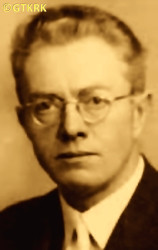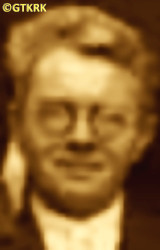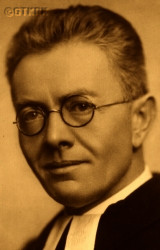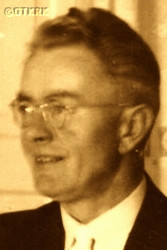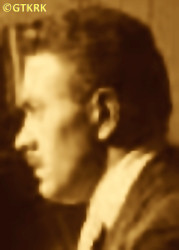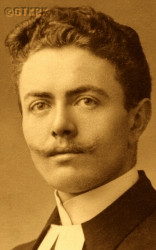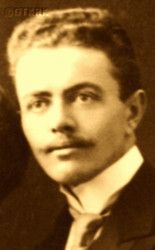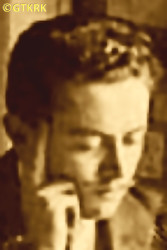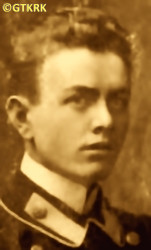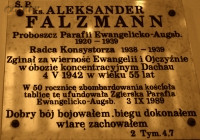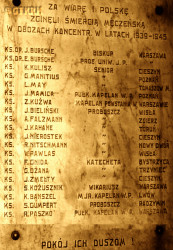Roman Catholic
St Sigismund parish
05-507 Słomczyn
85 Wiślana Str.
Konstancin deanery
Warsaw archdiocese, Poland
full list:
displayClick to display full list

searchClick to search full list by categories
wyświetlKliknij by wyświetlić pełną listę po polsku

szukajKliknij by przeszukać listę wg kategorii po polsku

Martyrology of the clergy — Poland
XX century (1914 – 1989)
personal data
surname
FALZMANN
forename(s)
Alexander Charles (pl. Aleksander Karol)
function
pastor
creed
Evangelical Church of the Augsburg Confession in Poland EA
diocese / province
Warsaw seniority (commissariat) / diocesemore on
en.wikipedia.org
[access: 2019.04.16]
honorary titles
Gold „Cross of Merit”more on
en.wikipedia.org
[access: 2019.04.16]
(09.11.1932)
date and place
of death
04.05.1942

KL Dachauconcentration camp
today: Dachau, Upper Bavaria reg., Bavaria state, Germany
more on
en.wikipedia.org
[access: 2016.05.30]
details of death
During World War I, after Battle of Gorlice in 05.1915 when German and Austro–Hungarian troops defeated Russians, voluntarily joined his evangelical parishioners and was deported by the Russians to Kharkiv (so‐called bezhenstvo).
Returned after the separatist German–Austrian–Russian peace treaty in Brest in 03.1918.
After German invasion of Poland in 09.1939 and start of the World War II, after start of German occupation, arrested by the Germans on 28.09.1939 (for the second time — the first time held shortly as a Polish hostage earlier in St Catherine church in Zgierz) by the Germans — based on Germ. „Sonderfahndungsliste” (Eng. „Special wanted list”) proscription list.
When asked stated that he was a Pole — and did not sign a Volkslist, a register of people claiming to be of German origin.
Jailed in prison on Sterling Str. in Łódź (or Anstadta Str. jail in Łódź).
Next held in Radogoszcz transit camp.
Tortured — immersed in a barrel of ice water (or faeces).
On 05.07.1940 transported to KL Dachau concentration camp and next on 30.08.1940 to KL Sachsenhausen concentration camp.
From there on 14.12.1940 taken back to KL Dachau concentration camp where perished — tortured, probably had phlegmon injected during so‐called „extermination: medical experiments”, found himself on the list of victims of so‐called Germ. „Invalidentransport” (Eng. „Invalids' transport”), destined for gas chambers.
Perished before transport.
According to the death certificate, prepared in KL Dachau, the „honest” otherwise German „medical doctors” and formalists — and at the same time, unrivaled fairy tale spinners — noted that the cause of death was Germ. „Versagen von Herz und Kreislauf, bei Darmkatarrch” (Eng. „Heart and circulatory failure, due to intestinal catarrh”).
prisoner camp's numbers
22821Click to display source page (KL DachauClick to display the description)
cause of death
extermination: exhaustion and starvation
perpetrators
Germans
sites and events
KL DachauClick to display the description, KL SachsenhausenClick to display the description, EtG RadegastClick to display the description, Łódź (Anstadta)Click to display the description, Łódź (Sterling Str.)Click to display the description, «Intelligenzaktion»Click to display the description, Collective responsibility („Hostages”)Click to display the description, Ribbentrop‐MolotovClick to display the description
date and place
of birth
24.08.1887

Łódźtoday: Łódź city pov., Łódź voiv., Poland
more on
en.wikipedia.org
[access: 2021.07.18]
parents
FALZMANN Robert Louis
🞲 28.09.1840, ? — 🕆 16.09.1917, ?

GRÖHNE Emily
🞲 16.04.1855, ? — 🕆 28.05.1929, ?
presbyter (holy orders)
ordination
08.12.1912

positions held
1920 – 1939
parish priest — Zgierztoday: Zgierz urban gm., Zgierz pov., Łódź voiv., Poland
more on
en.wikipedia.org
[access: 2021.12.18] ⋄ EA parish — also: 1938‐1939 councillor of the Consistory of the Evangelical–Augsburg Church in Poland — oath of allegiance to the Republic of Poland made on 30.09.1938
1914 – 1920
administrator — Mławatoday: Mława urban gm., Mława pov., Masovia voiv., Poland
more on
en.wikipedia.org
[access: 2021.12.18] ⋄ EA parish — with a break for the years 1915‐1918 and evacuation (i.e. bezhenstvo) to Russia
1914 – 1920
administrator — Pułtusktoday: Pułtusk gm., Pułtusk pov., Masovia voiv., Poland
more on
en.wikipedia.org
[access: 2021.12.18] ⋄ EA parish — with a break for the years 1915‐1918 and evacuation (i.e. bezhenstvo) to Russia
1912 – 1914
vicar — Łódźtoday: Łódź city pov., Łódź voiv., Poland
more on
en.wikipedia.org
[access: 2021.07.18] ⋄ St John EA parish
1908 – 1912
student — Dorpattoday: Tartu, Tartu city mun., Tartu cou., Estonia
more on
en.wikipedia.org
[access: 2023.03.24] ⋄ Evangelical Theology Department, University of Dorpat — also: member of „Polonia Convent” academic corporation
married — three children
comments
The urn with ashes — cremation prob. took place in the crematorium at the Germ. Ostfriedhof (Eng. Eastern cemetery) in Munich — since 1950 has been kept at the Am Perlacher Forst cemetery, in a place known as Germ. Ehrenhain I (Eng. „Remembrance Grove No. 1”), in Munich. In 2013, information about the „disclosure” of the cremated remains of the KL Dachau victims made it to the front pages of news outlets. His urn bears the No. K3330.
others related
in death
BANSZELClick to display biography Charles, BIELIŃSKIClick to display biography Joseph, BURSCHEClick to display biography Edmund, BURSCHEClick to display biography Julius, FREYDEClick to display biography Alfred, GNIDAClick to display biography Francis, GUMPERTClick to display biography Steven Edward, GUTKNECHTClick to display biography Bruno, GUTSCHClick to display biography Sigismund, HAUSEClick to display biography Paul Henry, KAHANEClick to display biography George, KOŻUSZNIKClick to display biography Stanislav, KULISZClick to display biography Charles, KUŹWAClick to display biography Sigismund, LEHMANNClick to display biography George, MAYClick to display biography Leo Witold, MAMICAClick to display biography Joseph, MANITIUSClick to display biography Gustav, NIEROSTEKClick to display biography Joseph, NITSCHMANNClick to display biography Adam Robert, OŻANAClick to display biography Gustav, PASZKOClick to display biography Richard, PAWLASClick to display biography Vladislav, WAGNERClick to display biography Richard Ernest, ZMEŁTYClick to display biography Adolph
sites and events
descriptions
KL Dachau: KL Dachau in German Bavaria, set up in 1933, became the main German Germ. Konzentrationslager (Eng. concentration camp) KL for Catholic priests and religious during World War II: On c. 09.11.1940, Reichsführer‐SS Heinrich Himmler, head of the SS, Gestapo and German police, as a result of the Vatican's intervention, decided to transfer all clergymen detained in various concentration camps to KL Dachau camp. The first major transports took place on 08.12.1940. In KL Dachau Germans held approx. 3,000 priests, including 1,800 Poles. The priests were forced to slave labor in the Germ. „Die Plantage” — the largest herb garden in Europe, managed by the genocidal SS, consisting of many greenhouses, laboratory buildings and arable land, where experiments with new natural medicines were conducted — for many hours, without breaks, without protective clothing, no food. They slaved in construction, e.g. of camp's crematorium. In the barracks ruled hunger, freezing cold in the winter and suffocating heat during the summer, especially acute in 1941‐1942. Prisoners suffered from bouts of illnesses, including tuberculosis. Many were victims of murderous „medical experiments” — in 11.1942 c. 20 were given phlegmon injections; in 07.1942 to 05.1944 c. 120 were used by for malaria experiments. More than 750 Polish clerics where murdered by the Germans, some brought to TA Hartheim euthanasia centre set up in Schloss Hartheim in Austria and murdered in gas chambers. At its peak KL Dachau concentration camps’ system had nearly 100 slave labour sub‐camps located throughout southern Germany and Austria. There were c. 32,000 documented deaths at the camp, and thousands perished without a trace. C. 10,000 of the 30,000 inmates were found sick at the time of liberation, on 29.04.1945, by the USA troops… (more on: www.kz-gedenkstaette-dachau.deClick to attempt to display webpage
[access: 2013.08.10], en.wikipedia.orgClick to attempt to display webpage
[access: 2016.05.30])
KL Sachsenhausen: In Germ. Konzentrationslager (Eng. concentration camp) KL Sachsenhausen, set up in the former Olympic village in 07.1936, hundreds of Polish priests were held in 1940, before being transported to KL Dachau. Some of them perished in KL Sachsenhausen. Murderous medical experiments on prisoners were carried out in the camp. In 1942‐1944 c. 140 prisoners slaved at manufacturing false British pounds, passports, visas, stamps and other documents. Other prisoners also had to do slave work, for Heinkel aircraft manufacturer, AEG and Siemens among others. On average c. 50,000 prisoners were held at any time. Altogether more than 200,000 inmates were in jailed in KL Sachsenhausen and its branched, out of which tens of thousands perished. Prior to Russian arrival mass evacuation was ordered by the Germans and c. 80,000 prisoners were marched west in so‐called „death marches” to other camps, i.e. KL Mauthausen‐Gusen and KL Bergen‐Belsen. The camp got liberated on 22.04.1945. After end of armed hostilities Germans set up there secret camp for German prisoners and „suspicious” Russian soldiers. (more on: en.wikipedia.orgClick to attempt to display webpage
[access: 2018.11.18])
EtG Radegast: Resettlement camp (as part of German resettlement „program” for Poles in 1939), then co‐functioning with transit‐concentration camp (during genocidal German «Intelligenzaktion» Litzmannstadt in 1939‐1940), finally changed into Germ. Erweitertes Polizeigefängnis (Eng. Expanded Police prison), in Radogoszcz n. Łódź, operational from 1939 till 1945, for Poles from Łódź region. Probably in excess of 40,000 people were held there. For religious this was a transit camp before transfer to KL Dachau concentration camp. (more on: en.wikipedia.orgClick to attempt to display webpage
[access: 2015.09.30])
Łódź (Anstadta): On 10.09.1939, the Germans entered Łódź and on 07.11.1939, in the building constructed in 1939 by the Jewish School Society at 7 Charles Anstadt Avenue (along with garage and warehouse facilities), located the local headquarters of the German Secret Political Police Gestapo. A detention center was set up in the basement. In the summer of 1944, 151 Gestapo officers worked there, supported by c. 690 registered agents. Investigations were conducted in the headquarters, the detainees were interrogated, tortured, and murdered in custody. After the German defeat and the beginning of the Russian occupation, the seat of the Commie‐Nazi Łódź Office of Public Security UB, the division of the genocidal Russian MGB. Activists of the Polish armed clandestine resistance were tortured and murdered in the same cellar arrest. It operated until 1956. (more on: nsz.com.plClick to attempt to display webpage
[access: 2013.10.05])
Łódź (Sterling Str.): Prison for men, founded in 1893, in a tenement houses at 16/18 Sterling Str. in Łódź, by the Russian occupiers (during partitions of Poland). In the interwar period, a Polish state prison. During World War II, a German police prison, used also by the Germ. Geheime Staatspolizei (Eng. Secret State Police), i.e. Gestapo. The prisoners were held in two three‐story buildings with 53 cells and 5 „sick rooms”. Interrogations of arrested Poles, combined with torture, as well as executions ‐ by hanging — were held there. After the German defeat and the beginning of the Russian occupation, the prison of the Commie‐Nazi of State Security Office UB — the unit of Russian genocidal MGB. Executions continued to take place there, this time of Germans and Poles convicted of collaborating with the German occupier, as well as of those convicted of anti‐communist activities and ordinary criminals. Closed in 1964. (more on: pl.wikipedia.orgClick to attempt to display webpage
[access: 2015.09.30])
«Intelligenzaktion»: German: «Intelligenzaktion» (English: „Intelligence Action”) — a German program of extermination of the Polish elite, mainly the intelligentsia and leadership layers, carried out from the beginning of the occupation in w 09.1939 to 04.1940, mainly in territories directly annexed to Germany, but also in the so‐called Germ. Generalgouvernement (Eng. General Governorate), where it was called «AB‐aktion». In the first phase, immediately after the beginning of the German occupation, during military operations carried out by the Germ. Wehrmacht (Eng. Armed Forces) and the genocidal units of the Germ. Einsatzgruppen (Eng. Operational Groups) of the Germ. Sicherheitspolizei (Eng. Security Police), i.e. SiPo, and Germ. Sicherheitsdienst des Reichsführers SS (Eng. Security Service of the Reichsführer SS), i.e. SD, organized by the Germ. Reichssicherheitshauptamt (Eng. Reich Main Security Office), i.e. RSHA, which followed the troops, carried out under the Germ. Unternehmen „Tannenberg” (Eng. Operation „Tannenberg”) — based on the so‐called Germ. Sonderfahndungsliste (Eng. Special Wanted Lists), i.e. proscription lists of Poles considered particularly dangerous to the Third Reich, prepared by the Zentralstelle II/P (Polen) unit of the German RSHA. Later, implemented by the German civilian occupation authorities and the genocidal unit of the Germ. Volksdeutscher Selbstschutz (Eng. Ethnic Germans Self‐Defense), whose members were Germ. Volksdeutsche (Eng. Ethnic Germans), i.e. representatives of the German minority in Poland. According to various sources, these lists, at the beginning of 09.1939, could have contained the details of 61,000—88,000 „dangerous” Poles — although these figures cannot be confirmed. In total, during this genocide, c. 50,000 teachers, Catholic priests, representatives of the landed gentry, freelancers, social and political activists, and retired military personnel were systematically and methodically murdered. Another 50,000 were sent to concentration camps, where only a negligible percentage survived. (more on: en.wikipedia.orgClick to attempt to display webpage
[access: 2014.10.04])
Collective responsibility („Hostages”): A criminal practice implemented by the Germans in the occupied territories of Poland, applied from the very first day of World War II. At its core was an appointment and public announcement of a list of names of selected people whose lives depended on absolute compliance with German orders. Any violation of these ordinances, by any person, regardless of the circumstances, resulted in the murder of the designated „hostages”. In the first days of the war and occupation, it was used i.a. by the German Wehrmacht army to prevent acts of continuation of the defense by the Poles. Later, especially in the German‐run General Governorate, it was part of the official policy of the occupation authorities — collective responsibility for any acts of resistance to the occupier's practices. For the life of one German, even if death was due to customary reasons, the Germans carried out executions from a dozen to even a hundred Poles previously designated as „hostages”.
Ribbentrop‐Molotov: Genocidal Russian‐German alliance pact between Russian leader Joseph Stalin and German leader Adolf Hitler signed on 23.08.1939 in Moscow by respective foreign ministers, Mr. Vyacheslav Molotov for Russia and Joachim von Ribbentrop for Germany. The pact sanctioned and was the direct cause of joint Russian and German invasion of Poland and the outbreak of the World War II in 09.1939. In a political sense, the pact was an attempt to restore the status quo ante before 1914, with one exception, namely the „commercial” exchange of the so‐called „Kingdom of Poland”, which in 1914 was part of the Russian Empire, fore Eastern Galicia (today's western Ukraine), in 1914 belonging to the Austro‐Hungarian Empire. Galicia, including Lviv, was to be taken over by the Russians, the „Kingdom of Poland” — under the name of the General Governorate — Germany. The resultant „war was one of the greatest calamities and dramas of humanity in history, for two atheistic and anti‐Christian ideologies — national and international socialism — rejected God and His fifth Decalogue commandment: Thou shall not kill!” (Abp Stanislav Gądecki, 01.09.2019). The decisions taken — backed up by the betrayal of the formal allies of Poland, France and Germany, which on 12.09.1939, at a joint conference in Abbeville, decided not to provide aid to attacked Poland and not to take military action against Germany (a clear breach of treaty obligations with Poland) — were on 28.09.1939 slightly altered and made more precise when a treaty on „German‐Russian boundaries and friendship” was agreed by the same murderous signatories. One of its findings was establishment of spheres of influence in Central and Eastern Europe and in consequence IV partition of Poland. In one of its secret annexes agreed, that: „the Signatories will not tolerate on its respective territories any Polish propaganda that affects the territory of the other Side. On their respective territories they will suppress all such propaganda and inform each other of the measures taken to accomplish it”. The agreements resulted in a series of meeting between two genocidal organization representing both sides — German Gestapo and Russian NKVD when coordination of efforts to exterminate Polish intelligentsia and Polish leading classes (in Germany called «Intelligenzaktion», in Russia took the form of Katyń massacres) where discussed. Resulted in deaths of hundreds of thousands of Polish intelligentsia, including thousands of priests presented here, and tens of millions of ordinary people,. The results of this Russian‐German pact lasted till 1989 and are still in evidence even today. (more on: en.wikipedia.orgClick to attempt to display webpage
[access: 2015.09.30])
sources
personal:
www.zgierz.luteranie.plClick to attempt to display webpage
[access: 2012.11.23], old.luteranie.plClick to attempt to display webpage
[access: 2012.11.23], estok.org.plClick to attempt to display webpage
[access: 2016.08.14], www.ipgs.usClick to attempt to display webpage
[access: 2012.11.23], ipn.gov.plClick to attempt to display webpage
[access: 2023.03.24], de.wikipedia.orgClick to attempt to display webpage
[access: 2016.08.14]
bibliographical:
„Urns kept at the Am Perlacher Forst cemetery — analysis”, Mr Gregory Wróbel, curator of the Museum of Independence Traditions in Łódź, private correspondence, 25.05.2020
„International Tracing Service (ITS), Bad Arolsen, GermanyClick to display source page”, Arolsen Archives
original images:
ipn.gov.plClick to attempt to display webpage
[access: 2023.03.24], ipn.gov.plClick to attempt to display webpage
[access: 2023.03.24], www.uml.lodz.plClick to attempt to display webpage
[access: 2016.08.14], estok.org.plClick to attempt to display webpage
[access: 2016.08.14], ipn.gov.plClick to attempt to display webpage
[access: 2023.03.24], estok.org.plClick to attempt to display webpage
[access: 2016.08.14], estok.org.plClick to attempt to display webpage
[access: 2016.08.14], ipn.gov.plClick to attempt to display webpage
[access: 2023.03.24], ipn.gov.plClick to attempt to display webpage
[access: 2023.03.24], estok.org.plClick to attempt to display webpage
[access: 2016.08.14], picasaweb.google.comClick to attempt to display webpage
[access: 2016.08.14], www.miejscapamiecinarodowej.plClick to attempt to display webpage
[access: 2013.12.04]
LETTER to CUSTODIAN/ADMINISTRATOR
If you have an Email client on your communicator/computer — such as Mozilla Thunderbird, Windows Mail or Microsoft Outlook, described at WikipediaPatrz:
en.wikipedia.org, among others — try the link below, please:
LETTER to CUSTODIAN/ADMINISTRATORClick and try to call your own Email client
If however you do not run such a client or the above link is not active please send an email to the Custodian/Administrator using your account — in your customary email/correspondence engine — at the following address:

giving the following as the subject:
MARTYROLOGY: FALZMANN Alexander Charles
To return to the biography press below:
 Click to return to biography
Click to return to biography








